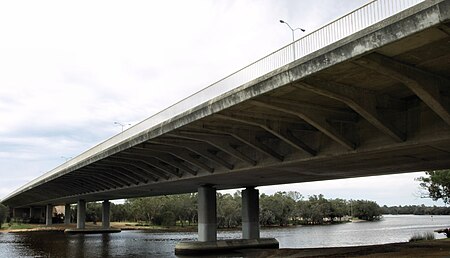Redcliffe Bridge, Perth

Redcliffe Bridge is a traffic bridge which carries Tonkin Highway across the Swan River between the Perth suburbs of Ascot and Bayswater. It is named after Redcliffe, which is a nearby suburb. Designed by Maunsell & Partners and built by Thiess Contractors, construction of the bridge started in 1986. The bridge was constructed using an incremental launch technique, and cost A$15 million to complete. It was officially opened on 16 April 1988. The bridge is 271 metres (889 ft) long, with five spans and a pre-stressed concrete deck 34 metres (112 ft) wide, supporting six lanes of traffic. The structure of the bridge is that of a hollow box girder, with the outer sides of the deck supported by special Y-beams.
Excerpt from the Wikipedia article Redcliffe Bridge, Perth (License: CC BY-SA 3.0, Authors, Images).Redcliffe Bridge, Perth
Tonkin Highway PSP, City Of Bayswater
Geographical coordinates (GPS) Address Nearby Places Show on map
Geographical coordinates (GPS)
| Latitude | Longitude |
|---|---|
| N -31.929734 ° | E 115.936637 ° |
Address
Redcliffe Bridge
Tonkin Highway PSP
6104 City Of Bayswater, Bayswater
Western Australia, Australia
Open on Google Maps







